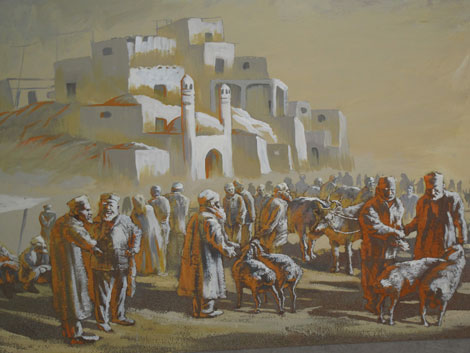Art
Red-hot art
Updated: 2011-05-12 07:56
By Shao Wei (China Daily)
|
 Alim at his Nefis Sand Art Paintings Hall in Yining, the Xinjiang Uygur autonomous region. Photos by Shao Wei / China Daily |
|
 A sand painting by Alim, featuring daily life in Xinjiang. |
A Uygur artist travels the great Taklimakan Desert for the purest sand to paint works that depict the landscape and everyday life of Northwest China. Shao Wei reports.
While the Taklimakan Desert, one of the world's largest, is out of bounds to most people, one can see, touch and even smell the sand at Nefis Sand Art Paintings Hall in Yining, a remote city in the Xinjiang Uygur autonomous region. Nefis, in the Uygur language, means "exquisite and delicate? says Alim, creator of the "Ili sand paintings? Holding up a bottle of red sand, the 42-year-old Uygur artist says: "This sand is from the Turpan Basin, east of the Taklimakan Desert. The scorching heat of the Flaming Mountains there has turned its yellow color to red."
The desert, also known in China as the "sea of death", is a treasure trove of material for Alim's work.
"Desert sand in various areas of Xinjiang has different colors, for example, some appear white, others green. They are very good materials for my paintings," Alim says.
Most sand paintings in inland China use dyed sand as it's more vivid than natural sand. But Alim doesn't agree.
"Even a grain of sand has life. My work embodies this life," he explains.
To underscore the natural look of his works, Alim does not encase them in glass or plastic.
Alim goes to great lengths to collect the best sand. He has crossed to the ancient city of Loulan - located in the eastern hinterland of the Taklimakan Desert - four times.
"The sand there is pure and mysterious," Alim says, "If the sand has dust it will crack the paintings," he says.
Collecting pure sand for his works, however, is nowhere as tough as ensuring it sticks together.
Born into a family of painters at Mohe'er Forestry Center of Gongliu county, in the Ili Kazak autonomous prefecture, Alim has been drawn to painting since childhood.
The idea of painting Xinjiang with the Taklimakan Desert sand crossed his mind in 2000. That led to a seven-year long search for a suitable glue by Alim and his wife.
In the beginning, the couple experimented with chemical glues.
"I bought nearly every kind of glue that could be found in the market. I spent four years visiting inland provinces, buying glues from the most expensive to the cheapest. But I couldn't find a suitable one," Alim recalls.
"Chemical glue failed to hold the pure, clean sand grains together," he says, "What's worse, the pungent smell killed the character of the sand."
At the time, Alim was a truck driver at the forestry center in his hometown. The cost of the glue and his journeys to remote areas to find the right one went far beyond his means.
"My wife's support sustained me. Or else, I would have given up," Alim says.
After countless attempts, the couple turned their attention to plants.
In 2007, their efforts finally bore fruit and Alim's "Ili sand paintings" came to national attention and were patented.
"The natural glue forms the core of the patent, and is also the secret of my paintings," he says, but demurs when asked about its components.
"I can only reveal one element of it," he says.
"The nettle is a common plant in Xinjiang's grasslands. Touching its beautiful leaves often leaves people with an itch. Interestingly, a yellow vine usually grows beside nettles and can help relieve this itch," he says.
"But the viscous juice of this vine also has glue-like properties."
Alim always invites visitors to his studio to smell and touch his paintings.
"It's a wonderful experience," he says.
Alim also "waters" his paintings at least six times before they are completed.
"Desert sand is dry and thirsty. I need to give them enough water so the grains glitter," he says.
So far, Alim has sold more than 200 paintings to visitors from home and abroad. They depict natural landscapes and everyday life in Xinjiang.
"A small-sized one (80 cm by 80 cm) costs around 10,000 yuan ($1,540)," Alim says.
"Although I try to use only the natural colors of the sand, for some pictures, this is not enough and I have to dye some parts, like green for grass and greenish-black for the lake."
He is now considering a new option. He is collecting stones of different colors and using their powder as a substitute for dyed sand.
E-paper

Thawing out
After a deep freeze in sales during the recession, China’s air conditioner makers are bouncing back
Cool Iron lady
Of good and evil
Build on security initiatives
Specials

Memory lanes
Shanghai’s historic ALLEYS not just unique architecture but a way of life

Great expectations
Hong Kong-born singer songwriter rises to the top of the UK pops.

A diplomat of character
Belgian envoy draws on personal fascination to help build China ties.
